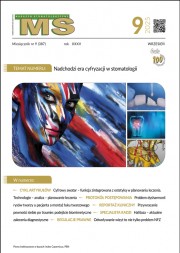Dostęp do tego artykułu jest płatny.
Zapraszamy do zakupu!
Cena: 12.50 PLN (z VAT)
Kup artykuł
Po dokonaniu zakupu artykuł w postaci pliku PDF prześlemy bezpośrednio pod twój adres e-mail.
MS 2021; 1: 57-59.
Paweł Mazurkiewicz, Małgorzata Światłowska-Bajzert, Ewa Sobolewska
Streszczenie
Ciągły postęp w zakresie diagnozowania i leczenia chorób stawu skroniowo-żuchwowego, a także przykre dolegliwości czynnościowe i bólowe towarzyszące zaburzeniom skroniowo-żuchwowym determinują poszukiwanie szczegółowych i spersonalizowanych rozwiązań diagnostycznych i terapeutycznych. W literaturze anglojęzycznej opisywany jest syndrom Ernesta związany z więzadłem rylcowo-żuchwowym, którego dokładnych opisów Autorzy nie znaleźli w literaturze polskojęzycznej i dlatego postanowili opisać tę mało znaną jednostkę chorobową.
Abstract
Continuous progress in the diagnosis and treatment of temporomandibular joint disorders, determines the need for detailed and personalized diagnostic and therapeutic solutions. Especially where consequences of such disorders include unpleasant functional and painful conditions. The English-language literature describes Ernest's syndrome associated with the stylomandibular ligament. Exact descriptions have not been found in the Polish literature, therefore Authors have decided to describe this little-known disease entity.
Hasła indeksowe: syndrom Ernesta, więzadło rylcowo-żuchwowe, zaburzenia skroniowo-żuchwowe
Key words: Ernest syndrome, stylomandibular ligament, temporo-mandibular disorders
PIŚMIENNICTWO
1. Peñarrocha-Oltra D, Ata-Ali J, Ata-Ali F i wsp. Treatment of orofacial pain in patients with stylomandibular ligament syndrome (Ernest Syndrome). Neurologia. 2013; 28(5): 294-298.
2. Cohen JR. The importance of using a specific diagnosis in evaluating and treating TMD. Cranio. 2019; 37(5): 275-277.
3. Cuccia AM, Caradonna C, Caradonna D. Manual therapy of the mandibular accessory ligaments for the management of temporomandibular joint disorders. J Am Osteopath Assoc. 2011; 111(2): 102-112.
4. Shankland WE 2nd. Anterior throat pain syndromes: causes for undiagnosed craniofacial pain. Cranio. 2010; 28(1): 50-59. Online: http://search.ebscohost.com/login.aspx?direct=true&db=mdc&AN=20158009&lang=pl&site=ehost-live&scope=site [dostęp: 21.08.2020].
5. Schmolke C. The relationship between the temporomandibular joint capsule, articular disc and jaw muscles. J Anat. 1994; 184 (Pt 2): 335-345.
6. Demerjian GG, Sims AB, Patel M i wsp. Head and neck manifestations of temporomandibular joint disorders. W: Demerjian GG, Barkhordarian A, Chiappelli F (red.). Temporomandibular Joint and Airway Disorders. Springer, Cham; 2018, s. 73-93.
7. Shankland WE 2nd. Ernest syndrome as a consequence of stylomandibular ligament injury: a report of 68 patients. J Prosthet Dent. 1987; 57(4): 501-506.














